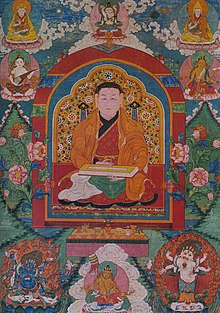
Tibetan art
Art of Tibet / From Wikipedia, the free encyclopedia
Dear Wikiwand AI, let's keep it short by simply answering these key questions:
Can you list the top facts and stats about Tibetan art?
Summarize this article for a 10 years old
The vast majority of surviving Tibetan art created before the mid-20th century is religious, with the main forms being thangka, paintings on cloth, mostly in a technique described as gouache or distemper,[1] Tibetan Buddhist wall paintings, and small statues in bronze, or large ones in clay, stucco or wood. They were commissioned by religious establishments or by pious individuals for use within the practice of Tibetan Buddhism and were manufactured in large workshops by monks and lay artists, who are mostly unknown. Various types of religious objects, such as the phurba or ritual dagger,[2] are finely made and lavishly decorated. Secular objects, in particular jewellery and textiles, were also made, with Chinese influences strong in the latter.[3]

.jpg/220px-Thiksey_Monastery_(28499443532).jpg)
Himalayan art is an overall term for Tibetan art together with the art of Bhutan, Nepal, Ladakh, Kashmir and neighbouring parts of Mongolia and China where Tibetan Buddhism is practiced.[5] Sino-Tibetan art refers to works in a Tibetan style and with Tibetan Buddhist iconography produced in either China or Tibet, often arising from patronage by Chinese emperors. The artists seem to have been a mixture of Tibetan and Chinese, with some Newari from Nepal,[6] and the place of manufacture is often uncertain between the two. The less common term of Tibeto-Chinese may be used when the Tibetan element is the stronger.[7]

Tibetan religious art has been described as "almost unbelievably conservative", to a large extent representing "the perpetuation of the forms and iconography of the last phase of Buddhist art of India". This was the Pala-Sena art of north-east India, relatively close to Tibet, and the home of key figures like Atisha, a missionary from Nalanda in Bihar. After the decline of Buddhism in India soon after, very little survives from the Indian Buddhist art of this or earlier periods except monumental sculpture, and art historians must deduce much about this vanished culture from Tibetan works.[8] Other influences on Tibetan art over the centuries came from Chinese and Nepalese Buddhist art.[9] Landscape backgrounds were adopted from Chinese painting from about the 14th century for some thanka,[10] and Chinese ornamental styles became dominant around 1700.[11]
The finest achievements are typically considered to be in painted thanka and small bronzes (often gilt-bronze), where the best works have very high levels of technical skill. These were generally private works, only seen within monasteries, and often specifically designed for meditation. More public art includes large statues for prayer halls, large appliqué thankas for temporary display during Tibetan festivals on thangka walls, and sand mandalas, also temporary.
